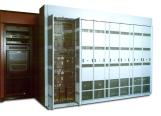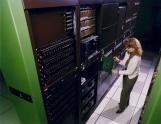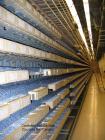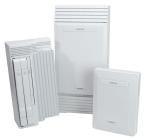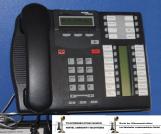15
The DMS-10 was Northern Telecom's first exchange digital switch, it was launched in the mid to late 1970s. It has kept pace with the latest technology to offer features such as IP telephony. It can support up 20, 000 lines. Where an old electro-mechanical switch would occupy a whole floor and consume a large amount of power, the DMS-10 can provide far more features in a handful of equipment bays with a fraction of the power. In addition where it took several months to install a central office switch now can be done in days.17
The DMS-500 local and long distance switch supports over 100,000 lines and or trunks.19
A typical older DMS line card, each subscriber's copper telephone line terminates on it. It is the interface to the DMS switch. Current versions are much smaller.21
The telephone lines come in the telephone office vault where then they are routed to the vertical side of the Main Distributing Frame (MDF). The lines are cross-connected to the horizontal side of the MDF pictured here. The horizontal side connects to the equipment serving the telephone lines. MDFs such as this one can have well over 100,000 lines terminated on them. Technology has reduced much of the telecommunications equipment but the MDFs have remained essentially the same from the early years.Internet Protocol (IP) telephony has revolutionized the industry. A Communications server accepts subscribers copper lines via voice gateways, these are then processed to another subscriber served by this server or routed to the internet to its ultimate destination. However, the communications server also supports analog, digital and IP phones in addition to PC clients. It can also accommodate large bandwidth clients. It can simultaneously process 100,000 calls. This can be accomplished with less than four equipment bays per 10,000 lines. The amount of power required is negligible in comparison to the 5,000 plus ampere plants of the past.
23
The Norstar is an integrated communications system designed for small to medium size businesses. It brings voice mail, fax, email, computer and telephone to the desktop. The smaller system supports three trunks (central office lines) and eight stations, the largest supports 56 trunks and 192 stations. This larger systems also support voice recognition.25
Nortel Business Series Terminals T7316E is a full-featured, expandable, multi-line telephone that has a two-line, 16-character-per-line display that is menu driven and supported by three context-sensitive soft keys. The T7316E provides access to 24 memory buttons, 16 of which include multi-segment icons for fast and precise decision making. It is designed for high call volume positions requiring access to extensive system features. Typical users include supervisors, managers, executives, and other business professionals. Text courtesy of Nortel.26
OC-3 Express Optical CarrierCirca 1996
Throughout Canada and USA
 Credits:
Credits:Telecommunications Museum
27
OC-3 Express fibre optic carrier supports three video channels. A video channel can be replaced by 672 voice channels all on a single hair thin fibre. The OC-3 is designed to serve businesses and small communities. Systems such as the OC-192 support 192 video signals or if only used for voice it can transport over 129,000 circuits. Since optical carriers use light as a transmission medium, different colours (wavelengths) can be used, up to 160 wavelengths would carry nearly 31, 000 video channels or 20.6 million voice conversations on a single glass fibre.As with any signal transmitted over distance it loses its strength, it must be amplified without distorting the multiple 10 gigabit signals. This signal is produced by a laser generating 10 billion pulses a second. Soliton note wave technology extends the reach of optical amplifiers so that only a few are needed to cross the continent. Prior to the availability of optical amplifiers, the light wave had to be decoded, regenerated and transformed into a new light signal every 40 km. The high capacity networks of today are the reason for the lowering of the cost of toll calls. Compare the cost of a call to Europe via radio link at $25 a minute to today's cost of less 5 cents a minute.
Note: A soliton is a solitary optical pulse that propagates itself without distotion in nonlinear and non dispersive optical fibre. Defintion courtesy of Futura-science.com.
